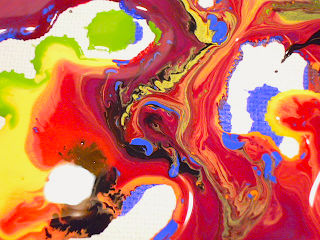Now that I've done spatter painting, eyedropper painting and bulletism, I decided that today might be a good time to try drip painting.
Drip painting, as the name implies, involves dripping or pouring paint onto a canvas. The first to experiment with this type of abstract art were artists such as Francis Picabia and Max Ernst, in the first half of the twentieth century. Ernst's famous Lissajous figures were created by the novel—and no doubt rather messy—means of swinging a punctured bucket of paint over a canvas lying flat. Tempting, but no.
The best-known proponent of drip painting, however, is Jackson Pollock. Using it to the exclusion of almost every other painting technique, Pollock employed sticks, hardened brushes, and turkey basters to create his large paintings. He generally used house paint for most of his works, because it was more liquid than oil paint.
 |
| Number 8 (detail), 1949 Jackson Pollock (1912–1956) Collection of the Neuberger Museum, State University of New York Source: http://www.ibiblio.org/wm/paint/auth/pollock/ |
Drip painting is said to have been inspired by techniques such as traditional Navajo sand painting, in which sand is trickled through the hand onto a surface lying flat on the ground. Navajo sand paintings are not created as works of art, however, but as part of elaborate healing rituals.
 |
| A Navajo sand painter at work. Source: http://www.artsology.com/navajo_sand_painting.php |
For today's elephant, I decided not to swing buckets of paint with holes in them, or pour house paint over a canvas pinned to the floor. Instead, I decided to simply to drip paint from bottles of acrylic paint onto a smallish canvas lying on top of a sheet of bristol board.
I was expecting the paint to be fairly hard to control, so I thought it might be handy to have some bamboo skewers around as well, just in case that might offer me a finer type of drip. If Jackson Pollock could use sticks, so could I. I had visions of this ending up looking like a really bad drawing by a deeply disturbed individual, but I figured that might be part of its charm. Or not.
I immediately discovered that the paint was too thick straight from the bottle, and that all I would get was a bunch of thick droplets if I used the paint at full strength. Instead, I found a small square plastic container that may once have held spaghetti sauce or something, and poured some paint into one corner, diluting it with a very small amount of water.
This made a paint that was too liquid, but short of pouring half the bottle of paint into a teaspoon of water, I decided to make the best of it.
As I suspected, this is very hard to control in any way. Although I carefully and slowly poured the paint from a fairly pointy corner of the plastic container, the streams of paint were wide, wiggly and quite wet.
After the first colour, I went away to work on some translations for about an hour, thinking this would give the paint time to dry. Not so much. Deciding that this activity would take all night if I waited to let the paint dry, I opted to just keep adding colours, letting them bleed into one another however they liked.
Allowing the colours to bleed made for some pretty and rather interesting effects, however.
Then I decided that a touch of black would accent it a bit better, although I used it sparingly.
I really hated this painting when I started and briefly thought of doing something else instead, but I'm actually pretty happy with the final result. I have no idea how long it will take to dry—I don't think overnight is going to do it—but I liked it enough that I may try this again, perhaps using a bamboo skewer next time to manipulate the paint while it's still wet.
Elephant Lore of the Day
The vaguely psychedelic paint patterns in this elephant reminded me that there is an Elephant Trunk Nebula in Space.
The Elephant Trunk Nebula is located about 2,450 light years from Earth in the IC1396 emission nebula complex in the constellation Cepheus. This area of dust and hydrogen gas is a sort of "stellar nursery" for young stars, and the top region of the Elephant Trunk is actually being blown away by radiation emitted from newborn stars deep within the nebula itself.
 |
| The Elephant Trunk Nebula (Van den Berg 142). Photo: Steve Cannista, 2004 Source: http://www.starrywonders.com/elephanttrunk.html |
To Support Elephant Welfare
Elephant sanctuaries
(this Wikipedia list allows you to click through to information on a number of sanctuaries around the world)
Performing Animal Welfare Society
Zoocheck
Bring the Elephant Home
African Wildlife Foundation
Performing Animal Welfare Society
Zoocheck
Bring the Elephant Home
African Wildlife Foundation








No comments:
Post a Comment